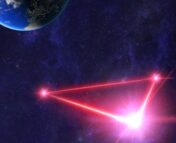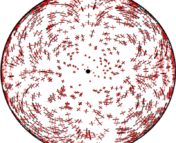Title: MBH binary intruders: triple systems from cosmological simulations
Authors: Mohammad Sayeb, Laura Blecha, Luke Zoltan Kelley
First Author’s Institution: University of Florida
Status: arXiv preprint [open access]
We at Astrobites have covered gravitational waves extensively. The first ever direct detection, named GW150914 after its discovery date of 14 September 2015, was produced by the merger of two stellar-mass black holes, and since then our catalog of confirmed gravitational wave detections has only continued to grow. We’ve been able to observe stellar-mass black hole and neutron star mergers, as well as the recently confirmed stochastic gravitational wave background, detected by pulsar timing arrays and likely created by a population of merging massive black holes (MBHs) over a million times the mass of the Sun. Individual MBH merger events will be detectable by the Laser Interferometer Space Antenna (LISA) after it launches in the early 2030s.
But these MBHs pose a bit of a theoretical problem, because we’re not quite sure exactly how they merge. Galaxies often merge with each other, and we know their central black holes likely merge as part of this process. However, models tend to put the MBH binary at the center of a merging pair of galaxies in a very stable orbit–so stable, in fact, that the time it would take the black holes to merge with each other is longer than 13.8 billion years, the age of the Universe! If we’ve already detected MBH mergers with pulsar timing arrays, they can’t take that long to happen.
Today’s authors consider one way that MBHs could be knocked closer together in a slightly shorter amount of time: the addition of a third black hole to the system.
Trouble with(out) triples

When NASA satellites Voyager 1 and 2 were sent to explore the outer solar system in the late 1970s, so-called “gravity assists” were used to change their trajectories and boost their speeds without using up fuel. This is illustrated in Figure 1. As each Voyager satellite passed Jupiter, it interacted with the planet gravitationally, stealing a small amount of Jupiter’s momentum in order to accelerate in a new direction. Because the satellite was so much smaller than the planet, an amount of momentum transfer that was highly significant to Voyager was negligible to Jupiter. But if we used this technique to redirect millions of satellites rather than a few dozen, we’d start to see Jupiter noticeably slow down and begin to fall towards the Sun.
This same effect causes the MBHs of merging galaxies to fall towards each other: as a black hole travels through a crowd of stars, it loses momentum in a process called dynamical friction. Once the MBHs are close enough together (on the order of tens of parsecs apart), they settle into a gravitationally-bound binary system. Their orbits begin to decay more slowly, as individual stars interact with the black hole binary and are slingshotted out into the galaxy in exchange for a little stolen momentum. Eventually, though, the system will run out of stars it is able to interact with and will stop losing energy–typically when the black holes are around a parsec apart, which is why this situation is called the final parsec problem.
A third MBH could shake up this too-stable orbit if another galaxy merges, but how common are these triple merger events? To investigate that question, the authors of today’s paper use the Illustris cosmological simulation to track a large population of merging galaxies over about 13.5 billion years. For each merger, they model the separation of the black holes over time, and track whether a third merger occurs. A schematic of this is shown in Figure 2, which illustrates three populations of potential MBH triples: a “failed triple”, in which a third merger occurs but the orbital radius of the new black hole is never equal to that of the existing central binary, a “strong triple”, where the third MBH enters the central binary at a separation of less than 100 parsecs, and a “weak triple” in which the triple system forms at a separation of more than 100 pc.

Gravity comes to the rescue
The authors found that 22% of MBH mergers in their simulations formed into triple systems and merged before the modern day, 71% of which would not otherwise have merged in time. This is a very significant fraction, and implies that MBH triple mergers form a large portion of the signals we expect from pulsar timing arrays and LISA.
In weak triples, the merger is likely driven by the Kozai-Lidov mechanism, in which the third MBH causes the first binary to oscillate wildly in orbital inclination and eccentricity, decaying rapidly until merger. In strong triples, the three-body interaction is even more chaotic and unpredictable. Interactions of this type often cause the least-massive MBH to be ejected from the system entirely as the other two merge, leaving it as a wandering, rogue black hole. A candidate for this type of object has already been observed, and if MBH triple interactions are as common as today’s authors predict, we should be able to find even more.
Today’s paper indicates that mergers in triple systems should be driving a large proportion of the stochastic gravitational wave background, as well as the events we expect to observe with LISA. MBH mergers are expected to be some of the highest-energy gravitational wave events in the Universe, and they should teach us a lot about how supermassive black holes and their environments work. Good thing these mergers actually happen, then!
Astrobite edited by Ivey Davis
Featured image credit: Katherine Lee




